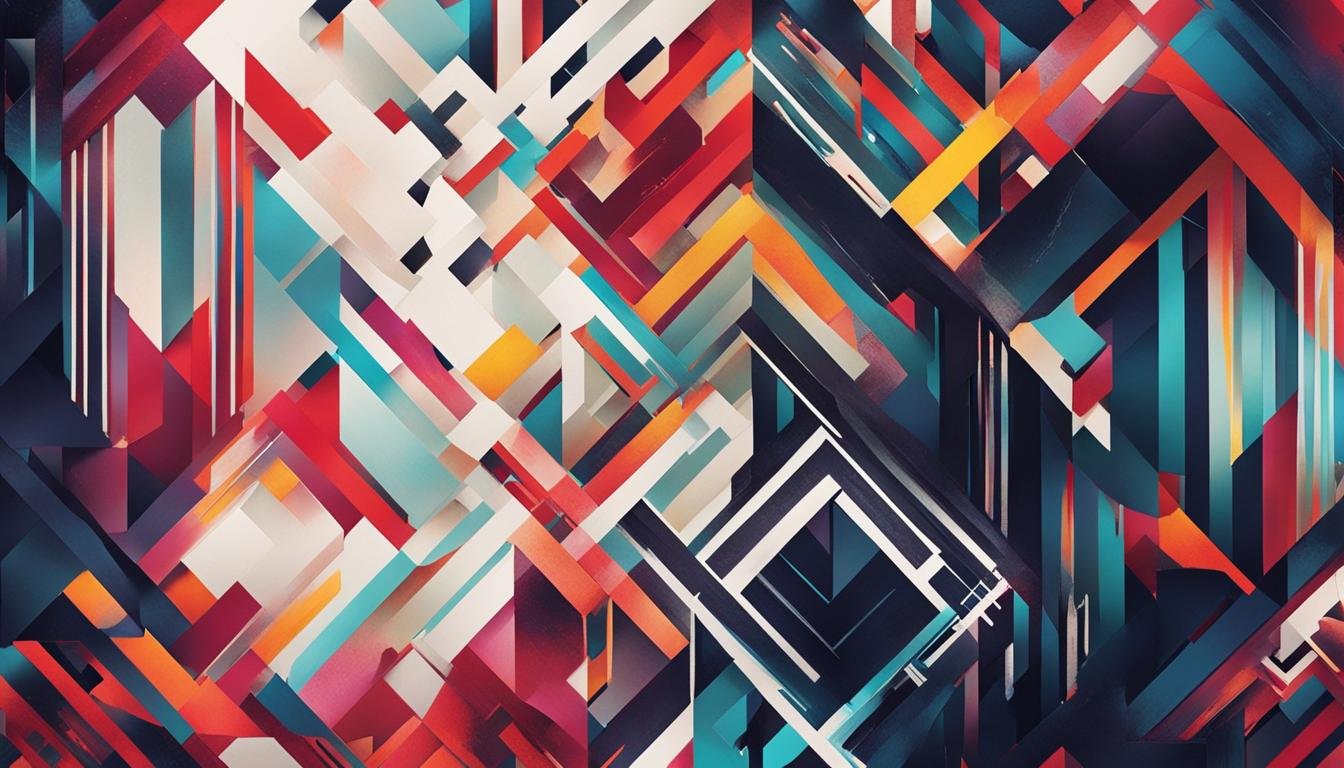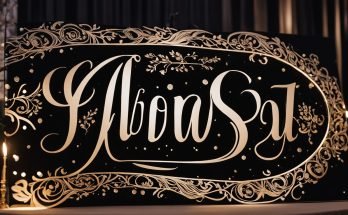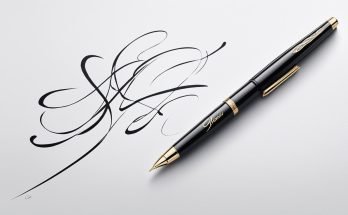Digital Calligraphy Trends: Unveiling the Future of Lettering in Art and Design
Digital calligraphy has taken the art of lettering to new heights. With the advent of special brushes and tablets like the iPad Pro, artists and designers are creating stunning calligraphy styles digitally. While hand lettering and calligraphy are similar, they have distinct differences. Calligraphy involves precise techniques using a pen nib and ink, while hand lettering focuses on drawing each letter as a unique entity in a composition. The rise of digital hand lettering is bridging the gap between traditional calligraphy and contemporary art, giving artists innovative tools to master the art of writing.
Key Takeaways:
- Digital calligraphy brings new possibilities to lettering techniques.
- Hand lettering is distinct from calligraphy, allowing for more creative freedom.
- Digital hand lettering offers accessibility and convenience for artists.
- Typography trends continue to evolve, combining art and design.
- Bubble fonts add playfulness and personality to typography.
The Art of Calligraphy: A Traditional Craft
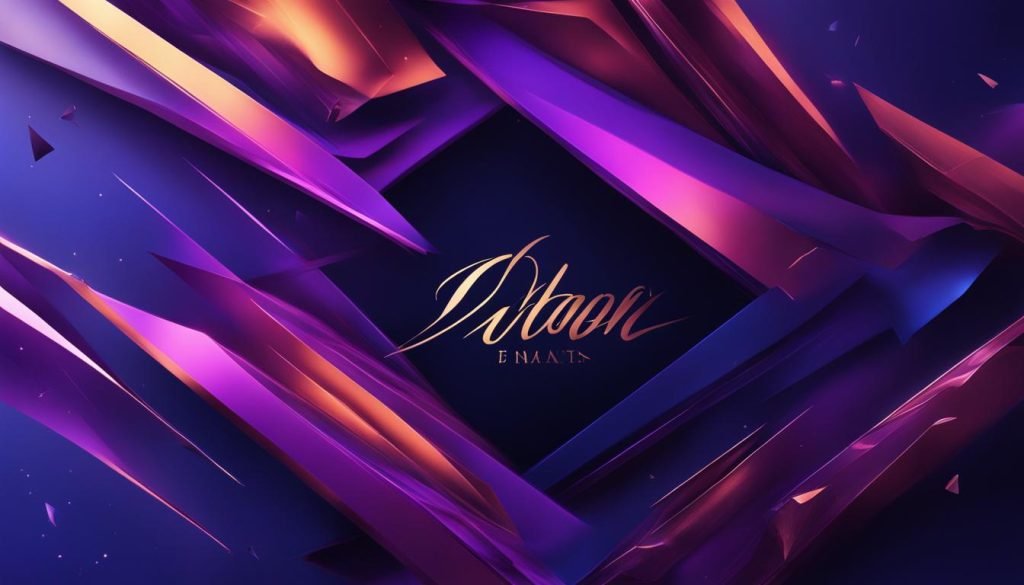
Calligraphy is an ancient art form that requires precision and skill. It involves writing with a pen nib and ink, following specific techniques to create beautiful letter strokes. Calligraphy techniques have been passed down through generations, with modern calligraphists continuing to embrace and evolve this traditional craft.
Learning calligraphy is like embarking on a journey of self-discovery. It requires patience, practice, and a deep understanding of letterforms. Modern calligraphists often choose different tools, such as fountain pens or traditional nibs, to create their distinctive style. Each stroke is carefully executed, bringing life to the letters and creating a harmonious composition.
Calligraphy is not just about writing; it is an art form that captures the essence of timeless elegance. It has the power to evoke emotions and convey messages in a way that no other form of writing can. With its rich history and enduring beauty, calligraphy continues to inspire and captivate both artists and admirers alike.
| Calligraphy Techniques | Description |
|---|---|
| Italic | Italic calligraphy emphasizes fluidity and elegance, with slanted and elongated letterforms. |
| Foundational | Foundational calligraphy focuses on the basic letterforms, serving as a foundation for other styles. |
| Uncial | Uncial calligraphy features rounded and interconnected letterforms, often used in medieval manuscripts. |
| Copperplate | Copperplate calligraphy is characterized by its delicate strokes and graceful flourishes. |
Calligraphy is a truly timeless art form. It connects us with the past, while allowing us to create something uniquely our own. The practice of calligraphy is not just about writing beautifully; it is also a meditative experience that brings a sense of calm and focus. As modern calligraphists, we have the privilege of carrying on this ancient tradition, infusing it with our own creativity and style.
Modern Calligraphists: Masters of Tradition
The art of calligraphy has found a new wave of enthusiasts in modern calligraphists. These talented artists are not only adept at traditional calligraphy techniques but also embrace contemporary styles and innovations. They blend the beauty of traditional calligraphy with modern design, creating captivating compositions that reflect their unique vision.
Modern calligraphists often experiment with different mediums, pushing the boundaries of the art form. They incorporate digital tools and techniques, combining traditional calligraphy with digital art to create stunning lettering designs. This fusion of old and new opens up exciting possibilities and allows calligraphists to reach a wider audience.
With their dedication to preserving the art of calligraphy while also pushing its boundaries, modern calligraphists are shaping the future of this classic craft. Their passion for letters and their commitment to honing their skills ensure that calligraphy continues to thrive in the digital age.
Calligraphy is an ancient art form that requires precision and skill. Modern calligraphists continue to embrace and evolve this traditional craft, infusing it with their own creativity and style. They experiment with different mediums, blending traditional calligraphy with digital art to create stunning lettering designs. This fusion of old and new ensures that calligraphy remains a vibrant and relevant art form in the modern world.
The Beauty of Hand Lettering
Hand lettering is an art form that allows for creative freedom and experimentation. Unlike traditional calligraphy, hand lettering focuses on drawing each letter as its own entity, giving artists the opportunity to explore various styles and compositions. With hand lettering, you can manipulate and fill each letter until it achieves the perfect shape within your design. This versatility has made hand lettering a popular trend among artists, designers, and enthusiasts alike.
Hand lettering requires practice and patience to develop the necessary skills. By dedicating time to honing your craft, you can create unique lettering styles that embody your personal artistic vision. Many hand letterers find inspiration and guidance from online tutorials, workshops, and communities where they can exchange tips and techniques. It’s a rewarding journey that allows you to continuously grow and refine your lettering skills.
The Art of Hand Lettering
Hand lettering is more than just writing letters. It’s about expressing emotions and conveying messages through the art of typography. Each stroke of the pen or brush becomes an intentional mark, and each composition tells a story. Hand letterers create designs that range from elegant and refined to bold and playful, showcasing the limitless possibilities of this art form.
| Benefits of Hand Lettering | Challenges of Hand Lettering |
|---|---|
|
|
Hand lettering is a beautiful way to add a unique and personal touch to your designs. It allows you to create custom lettering styles that perfectly complement the message you want to convey. Whether you’re designing a logo, a poster, or a wedding invitation, hand lettering offers endless possibilities for creativity.
Whether you’re an aspiring hand letterer or simply appreciate the beauty of this art form, hand lettering is a skill worth exploring. Through practice and dedication, you can develop your own style and create stunning lettering pieces that captivate and inspire. So grab a pen, brush, or tablet, and let your creativity flow as you dive into the world of hand lettering.
Digital Hand Lettering: The Future of Calligraphy
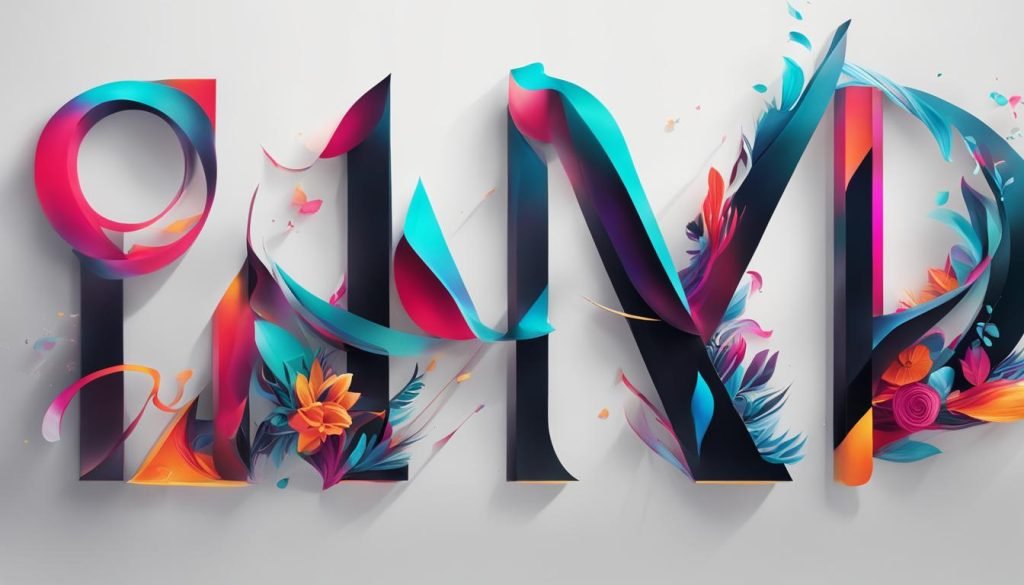
In today’s digital age, calligraphy is no longer confined to pen and paper. The art form has evolved, embracing technology and opening up new possibilities for creative expression. Digital hand lettering, in particular, has emerged as a powerful tool for artists and designers, revolutionizing the world of calligraphy.
With the rise of digital art and the availability of specialized brushes and tablets, artists can now explore calligraphy techniques digitally. The use of digital brushes allows for precise control over letter strokes, resulting in stunning and intricate designs. Additionally, artists no longer need to worry about ink smudging or running out of supplies. Digital hand lettering offers convenience and accessibility, making it an attractive option for both beginners and experienced calligraphers.
The advantages of digital hand lettering extend beyond practicality. The digital medium opens up a world of possibilities for experimentation and creativity. Artists can easily manipulate letterforms, explore various styles, and incorporate vibrant colors into their designs. This flexibility allows for a fusion of calligraphy and modern art, pushing the boundaries of traditional lettering and creating visually captivating compositions.
Typography plays a vital role in design, and digital hand lettering has become an integral part of this process. Designers can now seamlessly combine digital hand lettering with other design elements to create compelling visual experiences. Whether it’s in branding, advertising, or digital media, the future of calligraphy lies in the realm of digital art and design.
Table: Digital Hand Lettering vs. Traditional Calligraphy
| Aspect | Digital Hand Lettering | Traditional Calligraphy |
|---|---|---|
| Materials | Digital brushes, tablets | Pen nibs, ink, paper |
| Control | Precise control over letter strokes | Requires manual dexterity and technique |
| Accessibility | Accessible to beginners with minimal investment | Requires specialized tools and practice |
| Experimentation | Allows for easy manipulation of letterforms | Traditional techniques and styles |
As technology continues to advance, so does the future of calligraphy. Digital hand lettering is reshaping the way we perceive and practice this ancient art form. With its convenience, precision, and creative potential, it is no wonder that digital hand lettering is becoming the go-to choice for calligraphers and designers alike. Embrace the digital revolution, unleash your creativity, and explore the limitless possibilities of digital hand lettering in the world of typography.
Typography Trends: A Fusion of Art and Design

Typography plays a crucial role in the world of design, blending the elements of art and visual communication. It goes beyond the mere selection of fonts and colors, transforming text into a powerful tool for conveying information and evoking emotions. As the design landscape continues to evolve, typography trends follow suit, constantly pushing boundaries and exploring new possibilities.
Designers today are embracing a wide range of typography trends to create visually engaging and impactful designs. From the elegant and sophisticated serif fonts to the bold and dynamic sans-serif fonts, typography choices can shape the overall aesthetic and message of a design. Calligraphy design, in particular, has gained popularity, infusing a sense of artistry and elegance into typography.
“Typography is to literature as musical performance is to composition: they are not the same thing; they are interpretations of the composer’s—author’s—work.”
As technology advances, designers have also been exploring interactive and animated typography, bringing a new level of dynamism to their designs. This trend allows for the integration of motion and interactivity, captivating audiences and enhancing user experiences. By blending art and design, typography becomes a powerful storytelling medium, guiding viewers through a visual narrative.
Typography Trends:
- Vintage Styles: Nostalgic typography inspired by retro aesthetics, evoking a sense of timelessness and authenticity.
- 3D Typography: Creating depth and dimension with three-dimensional letterforms, adding visual impact and engaging viewers.
- Handwritten Fonts: Mimicking the personal touch of handwritten letters, lending a sense of warmth and intimacy to designs.
- Minimalist Typography: Embracing simplicity and clean lines, conveying a sense of modernity and sophistication.
Typography trends continue to evolve as designers experiment and push creative boundaries. By embracing these trends and incorporating them into their designs, designers can create visually captivating compositions that leave a lasting impression on their audiences.
The Rise of Unique and Interesting Typefaces
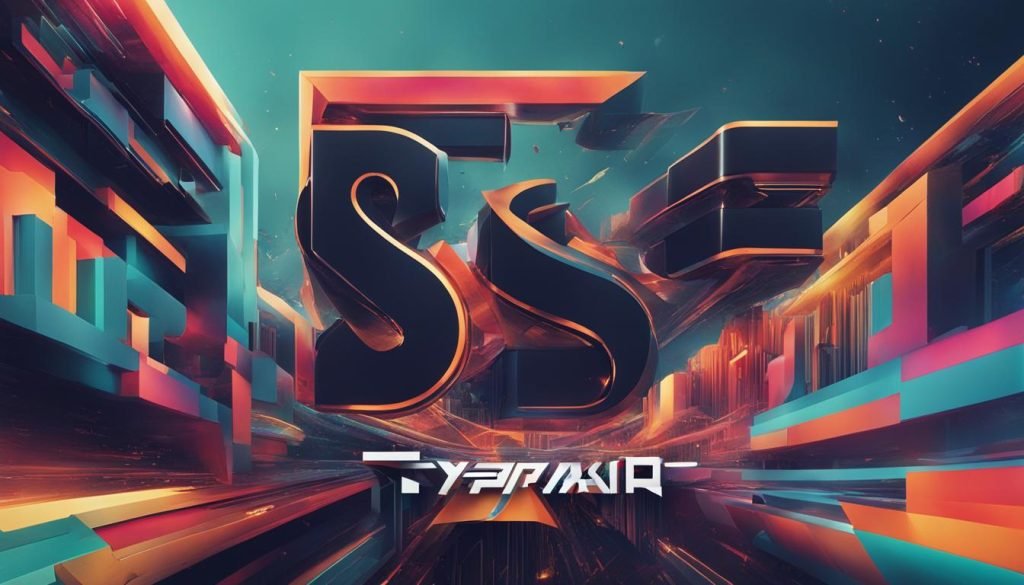
Designers are pushing the boundaries of typography by creating unique and interesting typefaces. Experimental typography allows designers to break free from traditional norms and create one-of-a-kind fonts that reflect a brand’s personality. This trend includes mixed fonts, flared fonts, and distorted typography, where designers manipulate existing fonts to create something new and visually captivating. The aim is to create legible yet visually striking typefaces that capture attention and convey a brand’s message effectively.
“Typography is the art of creating visual harmony with letters. With unique typefaces, designers can showcase their creativity and make a bold statement.” – Emily Martinez, Graphic Designer
Breaking the Mold: Mixed Fonts
Mixed fonts are becoming increasingly popular as designers experiment with combining different typefaces in a single design. This technique allows for the creation of visually engaging compositions that convey multiple messages or emotions. By carefully selecting complementary fonts, designers can create a harmonious balance between contrasting styles, creating a visually striking result.
Flared Fonts: Adding Personality
Flared fonts are characterized by exaggerated strokes and curved elements, adding a sense of playfulness and personality to typography. These fonts are often used to evoke a vintage or retro aesthetic, but they can also inject a modern twist into a design. With their unique shapes and distinctive style, flared fonts can instantly capture attention and create a memorable visual impact.
Distorted Typography: Breaking the Rules
Distorted typography takes existing fonts and manipulates them to create unexpected and eye-catching compositions. This experimental approach allows designers to challenge traditional typographic rules and create visually captivating designs. By stretching, warping, or rearranging letterforms, designers can create unique and intriguing typefaces that push the boundaries of conventional typography.
| Typeface | Description |
|---|---|
| Galactic Vibes | A futuristic typeface with bold and angular letterforms, inspired by space exploration. |
| Graffiti Street | A graffiti-inspired typeface that captures the edginess and urban energy of street art. |
| Whimsical Whirl | A whimsical typeface with swirling and playful letterforms, perfect for children’s books and playful designs. |
| Digital Dreams | An abstract and futuristic typeface, reminiscent of computer code and digital innovation. |
As designers continue to explore the realm of typography, unique typefaces and experimental typography will play an increasingly significant role in creating visually captivating designs. Whether it’s through mixed fonts, flared fonts, or distorted typography, the aim is to create typefaces that stand out, make a bold statement, and leave a lasting impression on the viewer. Embrace the creativity, think outside the box, and let your typography speak volumes.
Combining Colors and Fonts for Impactful Designs
When it comes to creating impactful designs, the combination of colors and fonts plays a crucial role. The right combination can evoke emotions, convey a brand’s message effectively, and capture the attention of your audience. Let’s explore some tips and trends for harmoniously combining colors and fonts in your designs.
1. Understanding Color Psychology
Colors have the power to evoke specific emotions and associations. For example, warm colors like red and orange often convey energy and excitement, while cool colors like blue and green can evoke a sense of calm and tranquility. When choosing colors for your design, consider the mood and message you want to communicate.
2. Creating Contrast
Contrasting colors can make your typography stand out and grab attention. Consider using complementary colors that are opposite each other on the color wheel, such as blue and orange or purple and yellow. This contrast creates visual interest and ensures that your text is easily readable.
3. Pairing Fonts with Intention
Selecting the right font for your design is essential. Each font has its own personality and conveys a different message. For example, serif fonts like Times New Roman are often associated with tradition and elegance, while sans-serif fonts like Arial are more modern and clean. When combining fonts, choose styles that complement each other and create a cohesive look.
| Color Combination | Font Combination |
|---|---|
| Black and Yellow | Avenir (Bold) and Playfair Display |
| Blue and Orange | Lato (Regular) and Bebas Neue |
| Purple and Green | Montserrat (Light) and Roboto Slab |
“The right combination of colors and fonts can elevate your design to a whole new level, making it visually appealing and memorable.”
Experiment with different color and font combinations to find the one that best suits your design and effectively communicates your message. Remember to consider the context and purpose of your design when making your choices. By combining colors and fonts strategically, you can create impactful designs that leave a lasting impression on your audience.
The Playfulness of Bubble Fonts
The world of typography is full of diverse and unique styles that can bring personality and creativity to any design. One such style that adds a playful and whimsical touch is bubble fonts. Inspired by cartoons and graphic novels, bubble fonts have the ability to evoke a sense of nostalgia or infuse a modern twist into a project.
When using bubble fonts, designers have the freedom to experiment with different letter shapes and sizes. The rounded edges and inflated appearance of the letters give them a friendly and approachable feel, making them perfect for designs aimed at a younger audience or those looking to add a fun element to their work.
Bubble fonts are versatile and can be used in various design mediums, from creating eye-catching headlines on posters to adding a touch of playfulness to app interfaces. Their ability to capture attention and ignite the imagination of viewers makes them a popular choice among designers who want to stand out and make a lasting impression.
“Bubble fonts bring joy and personality to any design, infusing it with a lightheartedness that can instantly capture the attention and imagination of viewers.”
Examples of Bubble Fonts
| Font Name | Style |
|---|---|
| Bubbly | Round and chubby letters |
| Bubblegum | Bright and bouncy letters |
| Bubble Pop | Playful and dynamic letters |
As you can see from the examples above, bubble fonts come in various styles, each with its own unique characteristics. Designers can choose a font that best suits their project’s tone and desired impact. Whether it’s a children’s book cover, a logo, or a social media graphic, bubble fonts can bring a touch of fun and playfulness to any design.
So, if you’re looking to infuse your designs with a sense of joy and whimsy, consider experimenting with bubble fonts. Let these playful typography choices bring your designs to life and create an unforgettable experience for your audience.
Conclusion – Digital Calligraphy Trends
The world of digital calligraphy is transforming the art of lettering, offering artists new tools and techniques to express their creativity. With the rise of digital hand lettering, the boundaries between traditional calligraphy and modern art are blurring. Artists can now learn calligraphy digitally, using tablets and specialized brushes, leading to precise control over letter strokes.
Typography trends are also evolving, providing designers with endless possibilities to create visually captivating compositions. From the elegance of serif fonts to the playfulness of bubble fonts, typography continues to shape the future of artistic expression. The fusion of colors and fonts has become a powerful tool for designers, allowing them to convey emotions and make a lasting impact.
As we look towards the future, it’s clear that digital calligraphy trends will continue to shape the world of lettering. With advancements in technology and the increasing popularity of digital tools, artists have a more accessible and convenient way to practice and master the art of writing. Whether you’re a calligraphy enthusiast or a designer looking to experiment with new typefaces, embrace these trends and witness the beauty of lettering unfold in the digital age.
FAQ – Digital Calligraphy Trends
What is the difference between calligraphy and hand lettering?
Calligraphy involves writing with a pen nib and ink, following precise techniques. Hand lettering focuses on drawing each letter as a unique entity in a composition.
What tools do calligraphists use?
Calligraphists often use fountain pens or traditional nibs to create their distinctive style.
What is the difference between digital hand lettering and traditional calligraphy?
Digital hand lettering allows artists to learn calligraphy techniques digitally using tablets and specialized brushes, eliminating the need for physical materials like ink and paper.
How does typography impact design and marketing?
Typography is essential in creating visually appealing compositions and plays a crucial role in conveying information and evoking emotions.
What are some current typography trends?
Typography trends include new serif fonts, vintage styles, 3D typography, and experimental typefaces.
What are unique typefaces?
Unique typefaces are one-of-a-kind fonts created by designers to reflect a brand’s personality, often including mixed fonts, flared fonts, and distorted typography.
How can color and font combinations create impactful designs?
By strategically combining colors and fonts, designers can create visually appealing compositions that captivate audiences and effectively convey a brand’s message.
What is the significance of bubble fonts in typography?
Bubble fonts add a playful and whimsical touch to typography, bringing joy and personality to designs.
What is the future of digital calligraphy and lettering?
Digital calligraphy and lettering are revolutionizing the art form, providing artists with new tools and techniques to express their creativity.

